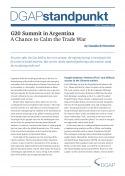Argentina holds the rotating presidency of the G20 informal group of key leaders of developed and emerging economies and is inviting them to Buenos Aires between 30 November to 1 December. President Mauricio Macri has earmarked three priorities, which he sees as particularly pressing for the South American country: the future of work, infrastructure as a developmental motor and sustainable food security.
Despite their importance, these topics are set to be overshadowed by recent global-trade tensions. The trade war between the U.S. and China as well as rising protectionism are endangering the stability of the international trade system and prospects for global economic growth. Even though trade and the global economy have always been high on the agenda since the key Washington summit in 2008, the groups first meeting about financial markets, it comes as a surprise that subject is raging again, just ten years after the global financial crisis. The reason it has reared its head again can be found in the protectionist trade policies in the United States.
In the light of the ongoing row, the meeting will be closely watched. The G20 presidency offers Argentina a chance to prove itself as a key partner of the group 19 most important industrialized and developing countries, plus the European Union. On the other hand, the chances of striking an agreement are scant, seeing as the conflict lines of the debate run straight through the G20.
Caught between “America First” and difficult access to the Chinese market
It will all hinge on how the big global trade players, the U.S., China and the EU, chose to behave at the summit. The 2018 country report of the Bertelsmann Stiftung’s Sustainable Governance Indicators (SGI) lists the manifold challenges weighing on the U.S. under President Donald Trump. These include „a dangerously excessive long-term budget deficit, increased economic inequality, the loss of well-paying middle-class and working-class jobs“. Trump gained power on the back of promises to bring well-paid industrial jobs back to the country, part of his “America First” policy. In addition he seeks to create trade relationships “fair,” according to the most recent SGI report, which stated the plan is “to cancel or renegotiate supposedly unfair trade deals”.
At the same time he is taking unilateral measures and is implementing punitive tariffs on China, and trading partners and allies such as Japan, Canada and the EU. This endangers existing trade partnerships and global supply chains. Meanwhile, doubts have been voiced about the World Trade Organization (WTO), the international organization that regulates trade and economic policies.
China, on the other hand, sees itself as an advocate of the liberal trading system and the WTO. However, with a glance at the current economic climate, serious market barriers continue to distort trade in favor of China. These include, among other things, high protective barriers, the subsidy practices of state-owned enterprises, the forced transfer of technology and the lack of protection of intellectual property.
The EU has taken a middle-of-the-road stance in this dispute. It shares the U.S.’s economic gripes about China, albeit to a lesser extent. In contrast to the U.S.’s unilateral approach, imposing punitive tariffs on almost all Chinese exports, the EU aims to solve the problems through bilateral, multilateral channels and WTO reforms.
The chances and limits of Argentina’s G20 presidency
The G20 provides an opportunity to air these conflicts. But this is also the problem. After all, the group’s ability to strike a common position depends on individual state’s willingness to cooperate. Informal groups like the G7 and G20 therefore reach their limits when faced with the uncompromising “America First” attitude of the USA.
So what can the G20 summit in Argentina achieve? Looking at the final declaration of the last G20 summit held in Hamburg in 2017, it is clear that the member states included conflicting positions in the statement in order to avoid a clash. On the one hand, it emphasized the importance of open markets and the fight against protectionism. On the other hand, the role of “legitimate trade defense instruments” was recognized in a bid to keep the U.S. on board. The central role of the WTO in world trade could not be mentioned because of staunch U.S. opposition.
These conflicts will continue to smolder in 2018. But there are some tentative positive developments. At the G20 trade ministers’ meeting in Mar de la Plata, Argentina in September, the G20 countries, including the U.S. and China, agreed that there is an urgent need to reform the WTO so that it can meet existing and future challenges. In contrast to 2017, the U.S. now recognizes the role of the WTO in world trade. China, too, supports this project, although it is at the center of WTO reforms.
It remains to be seen whether the G20 member states succeed in building on this initial agreement among their trade ministers. If, in late November, they manage to find common ground, backing WTO reforms to subventions, state-owned enterprises and the dispute settlement processes, it would serve to ease the tensions surrounding global trade. This would be an important step forward for the rules-based and transparent world trade system, but also an important achievement for the G20, which calls itself the central forum for international economic cooperation.

